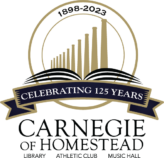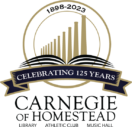by Daniel Ramseier
The Carnegie Library of Homestead frequently receives patron requests to assist with researching family history.
For their help I thank the librarians at Homestead and Main, the archivists at Pitt Archives, Megan Hendrick, Tina Zins and Iris Ramos.
Anyone can do family history with patience and luck. The only requirements are Internet access, a flash drive and a camera. Anything else can be planned and broken down into steps like cooking.
The first step is to settle on a name, the second to find out location, birth or death date, and any spelling and name changes, the third to Google the name. Once this is done, Ancestry can be used for free at any Allegheny County Library whereas Family Search is free. In order to make good use of Ancestry, it is important to find a relative who was born before 1940. If it is not possible to ask a relative or family friend, then it is necessary to find a public record listing relevant information, such as
- Birth Certificate
- Baptism
- Yearbook
- Marriage
- Divorce
- Immigration
- Military
- Death Certificate
- Obituary
- Cemetery Filing
Any relevant, including seemingly redundant information should be copied immediately into a Word File (Microsoft or Open Office) and saved on a flash drive. Documents (U.S. Census, death certificate etc.) can either be or saved as image. Originals (texts, photos etc.) can be photographed or scanned. These digital images can easily be renamed and put into system folders. Any saved date should listed either into system folders or tables, better known as spreadsheets. Tables basically are boxed lists, which can easily be changed, copied and converted into Excel spreadsheets to make the information easier to search. It is important to make backup files (paper, phone, computer, e-mail, Facebook).
Cropping
Some images may be too large, of no particular interest whereas some details, like a signature, may be have some importance to be saved separately. The first step is to download an image, the second to click on open, just below Windows Photo Viewer, the third to choose Paint and then to hit Select The option of Rectangular Selection allows to crop and copy the desired image.
Sanborn and Google Maps
Any name or address by itself has no meaning. Google maps and Wikipedia entries allow to make visual sense of locations. The satellite photo first provides a sense of an area and the town layout. A closer look may identify buildings. The street view may show whether a found address can be matched with a building. The panoramic town maps around 1900 provided the same information in print and can be easily be found online. The G.M. Hopkins Company printed county and town maps from the 1870’s to the 1930’s which can be found online; Historic Pittsburg lists their Allegheny County maps. The Sanborn maps (see Wikipedia entry) were colored insurance maps detailing building structures, indexing streets, and most importantly listing owners and shops. This is important especially for towns without any known or online directories. Ancestry has incomplete sets of U.S. Directories from 1822 to 1992 which can be searched name or by town and year, but the search results may not reliable. The Sanborn Maps can be found online at Penn State.
Reading
It is easy to get click drunk and to overlook or forget details when repeatedly reading the same basic information in a directory or U.S. Census. Ancestry family trees can be useful shortcuts to exclude namesakes and to identify siblings, parents and children, but always have to be checked for their accuracies. Cemeteries records can be found online (cemetery, free pages, Find a Grave), but tend to be incomplete. Ancestry has Find a Grave which may list grave, relatives, photos, obituaries, death certificates, family history. If Find a Grave does not list the spouse or relatives, then the cemetery record should be checked to find any other family members buried at the same or different cemetery. The name and date may allow to find an obituary through Post-Gazette Historical Archives. This site requires a subscription, but may allow free use of older entries; the search settings differ at home and the library. The Carnegie Library of Pittsburgh has large a collection of microfilmed newspapers and the online version of the Pittsburgh Courier which was a prominent African American newspaper, now in print again (see Wikipedia entry). The McKeesport Historical Society has the microfilmed Daily News.
Library Assistance
Researching family history outside the county, state and country, at best, is challenging. The Pennsylvania Department of the Carnegie Library of Pittsburgh has large collections on family histories as well. The library has detailed information on their website. For overcoming dead ends, it is best to talk to a librarian in person or ask for a one hour appointment with a Librarian (412-622-3154).

